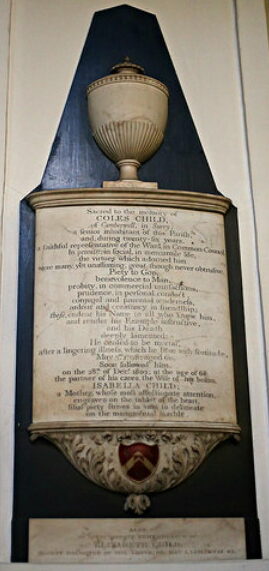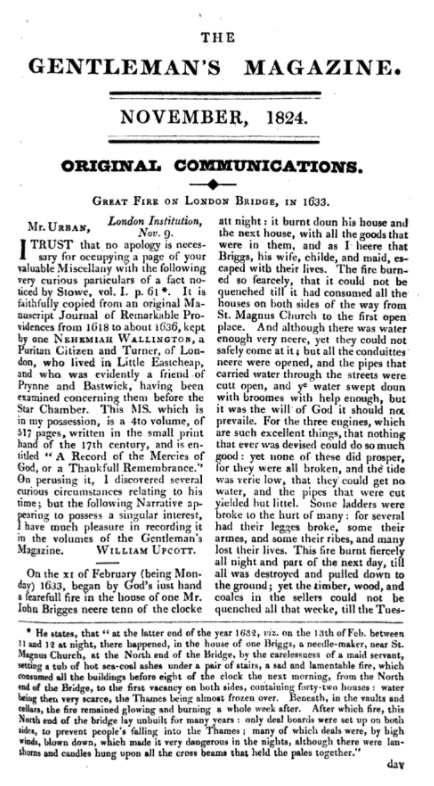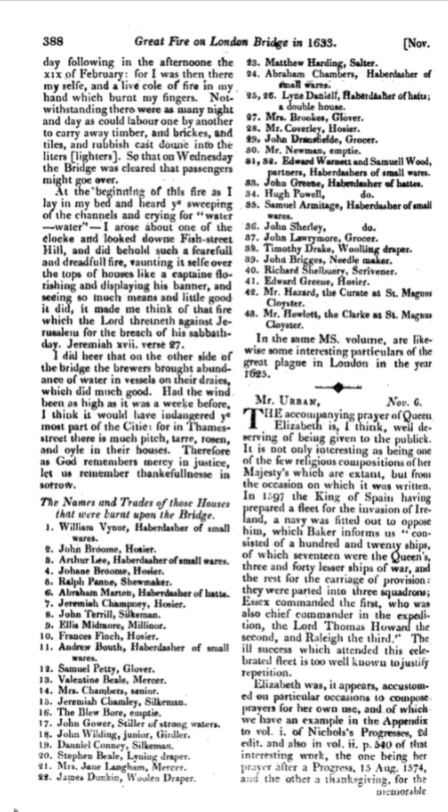Behind the font is one of the church’s three benefaction boards, which is considered one of the finest in the City and records gifts made between 1640 and 1700. The main panel is flanked by festoons descending from cherub-heads, with a cornice and broken segmental pediment above. In the centre of the latter there is a cartouche with a painting of Charity with three infants. The inscription records the bequest of Susannah Chambers, who:
by her last will & testament bearing date 28th December 1640 gave the sum of Twenty-two shillings and Sixpence Yearly for a Sermon to be preached on the 12th day of February in every Year within the Church of Saint Magnus in commemoration of God’s merciful preservation of the said Church of Saint Magnus from Ruin, by the late and terrible Fire on London Bridge. Likewise Annually to the Poor the sum of 17/6.
St Magnus narrowly escaped destruction in 1633, an edition of Stow’s Survey recording that:
On the 13th day of February, between eleven and twelve at night, there happened in the house of one Briggs, a Needle-maker near St Magnus Church, at the North end of the Bridge, by the carelessness of a Maid-Servant setting a tub of hot sea-coal ashes under a pair of stairs, a sad and lamentable fire, which consumed all the buildings before eight of the clock the next morning, from the North end of the Bridge to the first vacancy on both sides, containing forty-two houses; water then being very scarce, the Thames being almost frozen over.
Also recorded is the gift in 1700 of the clock and dial by Alderman and Sheriff Sir Charles Duncombe at a cost of £184 5s 4d, although a publication of 1708 records the amount as £484 5s 4d. The parish marked this civic munificence with a printed sermon:
The good Samaritane A sermon preached at the parish-church of St. Magnus the Martyr, by London-Bridge, the 13th Sunday after Trinity, being August 25. 1700, upon the Holy Gospel for the day. Printed at the request of the church-wardens, and others of the chief auditors, and humbly dedicated to Sir Charles Duncombe, Knight, and alderman of the ward of Bridge. On account of the most unwonted sort of charity, and noble generosity, which the City of London, and particularly the parish of St. Magnus has lately tasted of. By Richard Holland, M.A. chaplain to His Grace the D. of Richmond, curate of St. Magnus, and lecturer of Alhallows the Great.
Daniel Defoe was less impressed, publishing a satire of Duncombe in The True-Born Englishman (1700):
And lest examples should be too remote,
A modern magistrate of famous note,
Shall give you his own history by rote.
I’ll make it out deny it he that can,
His worship is a True-born Englishman,
In all the latitude that empty word
By modern acceptation’s understood.
The parish-books his great descent record,
And now he hopes ere long to be a lord;
And truly, as things go it would be a pity
But such as he should represent the city;
While robbery for burnt-offering he brings,
And gives to God what he has stole from kings!
Great monuments of charity he raises,
And good St. Magnus whistles out his praises.
To city gaols he grants a jubilee,
And hires huzzas from his own mobilee.
Lately he wore the golden chain and gown,
With which equipp’d, he thus harangued the town;

Near this benefaction board is a memorial to Coles and Isabella Child, who were first cousins. The Child family had a connection with the parish and with Bridge Ward for several generations.
Coles Child (1702-71), a member of the Weavers’ Company, was living in the parish at the time of the baptism of his oldest daughter Isabella in 1734. After leasing a shop at the sign of the Blue Boar on old London Bridge in 1744 he appears regularly in trade directories. A trade card exists from c1755 listing the large variety of items sold by the Child family from toys and needles to whalebone busks and gun flints. He took his nephew, Coles Child (1738-98) as his apprentice in 1753. Having completed his apprenticeship Coles Child Junior became a Common Councilman for Bridge Ward and married his first cousin Isabella (1734-1802) at St Magnus in 1762. His arms Gules, a chevron engrailed ermine between three eagles close argent, as shown on the memorial, include those of his wife, an heraldic heiress, on an escutcheon of pretence, but as first cousins the arms are the same.
Their sons, William (1765-1837) and Coles (1775-1831) each served as Master of the Merchant Taylors’ Company, in 1811 and 1816 respectively. William was one of the founders of London Life Assurance and followed his father as a Common Councilman for Bridge Ward, serving as the Ward Deputy (i.e. deputy to the Alderman). His son, William Knox Child DL (1793-1874), was also a Common Councilman for Bridge Ward, before emigrating with his family to Sydney in 1840, where he established Australia’s first sugar refinery. After retiring to his estate at Mt Vincent he donated land for Christ Church Mt Vincent and funded the construction of the first two church buildings. His son, the Venerable Coles Child MA (1817-1898), who was baptised at St Magnus, was Archdeacon of Newcastle NSW.
In the narthex there is an 18th century tablet from the neighbouring church of St. Michael Crooked Lane, which was demolished in 1831 to make way for King William Street. The parish was united to that of St Magnus the Martyr with St Margaret New Fish Street.
The third benefaction board, also from the 18th century, is plain in design but carries an interesting inscription regarding a serious fire in 1760 that did considerable damage to the church itself and burnt warehouses to the south of the church and a number of houses on the northern end of London Bridge. It also records the effect of the bridge improvements of 1762 to 1763, which necessitated alterations to the west end of the church and the opening up of the side arches so that people could pass underneath the tower.
This Table was here placed as a memorial of a dreadful fire which suddently broke out with great violence about ten o’clock in the morning on the 18th of April 1760, at an oyl shop adjoining to the South-East-end of this church, which instantly consumed the Vestry-Room, burnt most part of the roof of the church, greatly injured the organ, and did very considerable damage to the whole fabric. The said church was repaired and beautified, with the utmost expedition, the organ reinstated, and made good again, and a Vestry Room erected, at the North-West end, at the sole expence, of the United Parishes, of St Magnus the Martyr, and St Margaret New-Fish-Street, which amounted in the whole, to the sum of £1200, and upwards.
The Vestry-Room at the North-west end, and the South-west, and the South-west and North-west corners of the Church being taken down by the City of London, for ye purpose of making a passage under the Steeple, pursuant to an Act of Parliament made in the year of our Lord, one Thousand, Seven Hundred and Sixty-two, for enlarging and improving the North-east avenue of London Bridge, another Vestry Room with an Engine-house was thereupon erected, agreeable to the said Act of Parliament on the South side of the said Church by, and at, the expense of the said City and furnished at the charge of the united Parishes of St Magnus the Martyr, and St Margaret new Fish-street, in the year of our Lord, one Thousand Seven Hundred and Sixty-eight.


